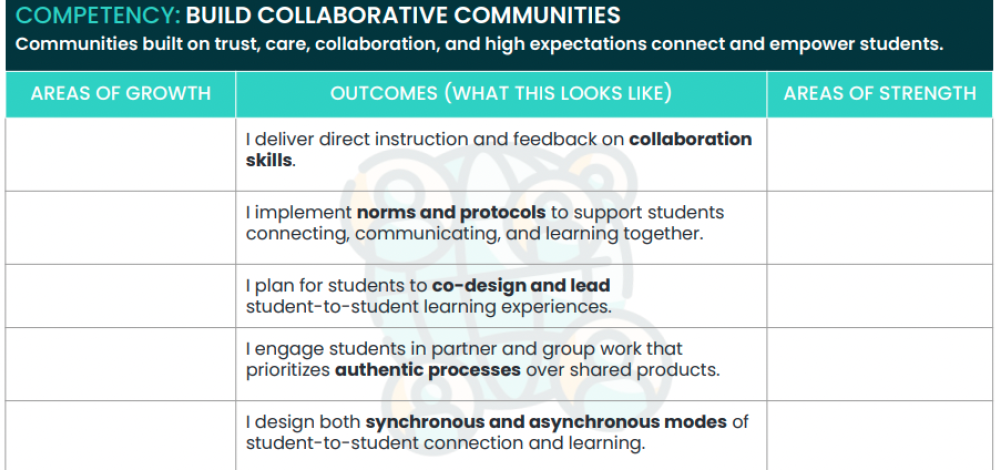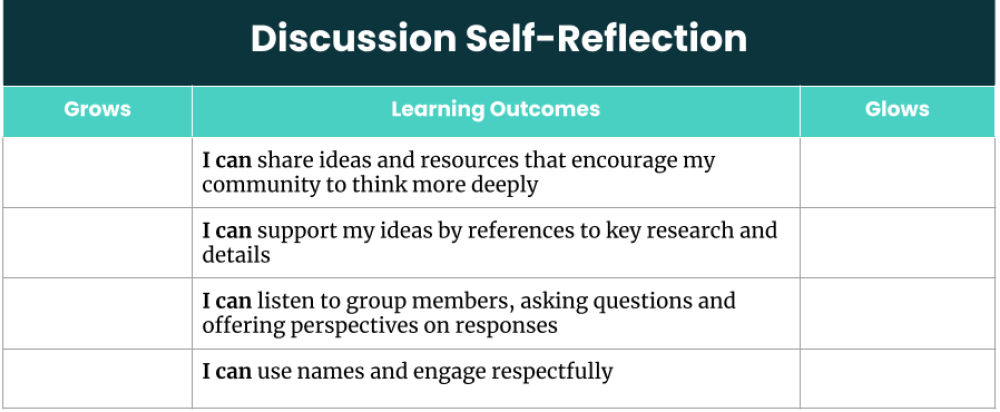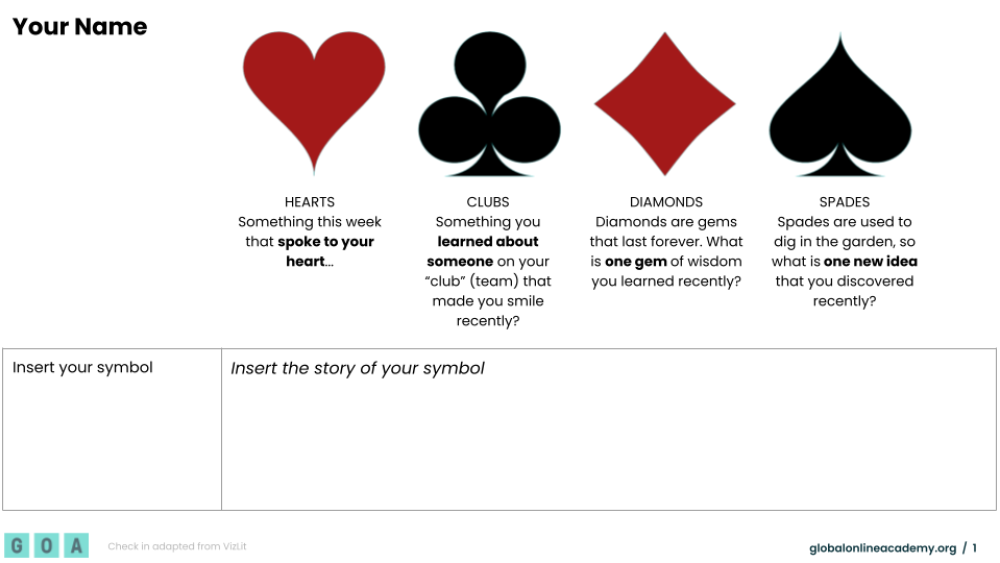Building Collaborative Communities: Five Look-Fors
We know collaboration matters. It's an essential lifelong skill. It's how many of us build connections and relationships. To both the adults in our schools and the students in our classrooms, collaboration is a pathway towards communities that work, play, and trust together.
In the Cult of Pedagogy blog post, "No More Easy Button: A Suggested Approach to Post-Pandemic Teaching," Jennifer Gonzalez reflects on the shifts in practice required post-pandemic. She shares, "I want to emphasize that I'm not talking about MORE. I'm talking about different." She's talking about refining what we do as educators, shifting practice for more meaningful experiences for our students. Especially as we reflect on the ramifications of the pandemic’s isolation, collaboration is one of the urgent areas where we need to shift to something different.
At GOA, as a part of our Educator Competencies, we've developed a rubric of look-fors to affirm and to grow our practice. We invite you to explore these five look-fors, considering their relevance to both your work with students and your work with adults. How might we prioritize collaborative communities among all stakeholders? How might we, as Jennifer Gonzalez advocates, not do MORE--but do DIFFERENT?

Look for #1: I deliver direct instruction and feedback on collaboration skills.
A starting point for ensuring our communities work meaningfully together is ensuring that all of us know what we're talking about when we talk about collaboration. It's more than the divide and conquer approach many of us experienced as students ourselves. It's more than sitting next to a partner and checking each other's work. Collaboration, like most skills, requires the implicit to be made explicit. What does collaboration look like and sound like? How do we meaningfully engage? Articulating what collaboration skills are and look like empowers learners.
At GOA, our students reflect on Core Competencies, including "collaborate with people who don't share your location." We offer outcomes for reflection and goal-setting:
Connection: You share ideas and resources with your peers that encourage them to think more deeply.
Interaction: You actively listen to group members, ask questions in response to their ideas, and respond respectfully.
Flexibility: You reconsider and revise your ideas based on the merits of others' ideas and the ideas reflected in the content of the course.
Originality: Your contributions to the work are original and reflect your own voice.
Teamwork: You openly acknowledge the contributions of team members and seek equitable sharing of work.
Look for #2: I implement norms and protocols to support students in connecting, communicating, and learning together.
In The Power of Protocols for Equity, Zaretta Hammond shares, "...to grow students' brain power using academic conversation as a strategy, we need robust talk structures that allow more students to join in the conversation confidently, especially English learners, introverted students, disengaged students, and historically marginalized students." From check-in prompts to discussion protocols, when students and colleagues have structures for engagement, everyone benefits from increased comfort levels and contributions.
Co-designing norms for discussion is a starting point for establishing parameters that offer all students access into a conversation. The result is a shared language that students can use for self-reflection and for growth.

As both faculty and as students, framing discussions with prompts for pre-thinking, during-discussions sharing and post-reflection, allows all students the time and space they need to contribute. Harvard's Teaching and Learning Lab offers a robust list of discussion frameworks that support both asynchronous and synchronous conversations.
Look for #3: I plan for students to co-design and lead student-to-student learning experiences.
When we take time to model collaboration skills and to plan for students to practice them, students have the scaffolding they need to lead their own learning.
A helpful starting point to model in student-to-student collaborative learning is feedback routines. Peer-to-peer feedback structures, like John Spencer's 20-Minute Peer Feedback System, can be conducted without an educator present. In GOA's Fiction Writing course, students engage in this feedback method in their own Zooms, reflecting on their takeaways and what they will revise as a result of the student-led conversations. Because they know what good feedback looks and sounds like, they are equipped to join in conversations purposefully, relying on one another to support questions and challenges in the drafting process.

Excerpt from GOA’s Fiction Writing Course Peer Feedback Guidelines.
Look for #4: I engage students in partner and group work that prioritizes authentic processes over shared products.
"You write the report, I'll draw visual aid, and you give the presentation." Sound familiar? Dividing tasks for a shared product is not only ineffective collaboration, it's deeply problematic when grading for equity. Shared products don't allow for accurate measurements of individual skill growth and create tensions between students on workload and achievement.
Many of us partner in PLCs, co-develop curricula, and plan in small groups. Group work is necessary across contexts in and out of school. What's required with group work is a redefinition for more equitable grading and more meaningful learning. What’s required is a switch from prioritizing the shared product to prioritizing the shared process.
From reflection to brainstorming to feedback to discussions, we can engage students throughout a learning process in collaborative experiences transforming a divide-and-conquer approach to creating a shared product into a shared experience where everyone grows in skills and connection.
In GOA's Entrepreneurship in a Global Context course, students partner in experiencing Design Thinking together, working to prototype an innovation. Their assessment is not based on the prototype; it's a self-reflection on personal contributions and takeaways. The process of the experience empowers students to lead their own Design Thinking processes in a future project where they develop personal start-up plans.

Look for #5: I design both synchronous and asynchronous modes of student-to-student connection and learning.
Whether your student or adult school communities meet in person or on Zoom, offering both asynchronous and synchronous options for how they collaborate invites all voices to engage and creates artifacts that support ongoing reflection.
In a recent GOA staff meeting, Deepjyot Sidhu, Director of Organizational Culture, assigned each team member a slide in a shared slidedeck to highlight an experience from the past week:

The slide deck offered everyone choice, creating safe spaces for folks to share a story that aligned to comfort levels. Asynchronously, each person completed their slide and then synchronously, the GOA team commented on all slides with what they liked, noticed, and wondered. All voices were heard and seen as conversations grew. We walked away with shared inspiration, new learnings, affirming messages, and next steps. In a student context, a quiet slide conversation has potential to develop relational connections between students, to provide safe parameters for different comfort levels to engage, and to support all learners with gathering new ideas.
Taking time to define and redefine collaboration leads communities to engage in meaningful work and develop lasting connections. Let's disrupt the divide-and-conquer approach; let's do something different and nurture collaborative communities where meaning-making and relationship-building are the new group work.
For more, see:
Looking Ahead: Why Relationships Must Drive School Innovation
How to Build Collaborative Communities: Shifts and Strategies for Teachers

This post is part of our Shifts in Practice series, which features educator voices from GOA's network and seeks to share practical strategies that create shifts in educator practice. Are you an educator interested in submitting an article for potential publication on our Insights blog? If so, please read Contribute Your Voice to Share Shifts in Practice and follow the directions. We look forward to featuring your voice, insights, and ideas.
GOA serves students, teachers, and leaders and is comprised of member schools from around the world, including independent, international, charter, and public schools. Learn more about Becoming a Member. Our professional learning opportunities are open to any educator or school team. Follow us on LinkedIn and Twitter. To stay up to date on GOA learning opportunities, sign up for our newsletter.
